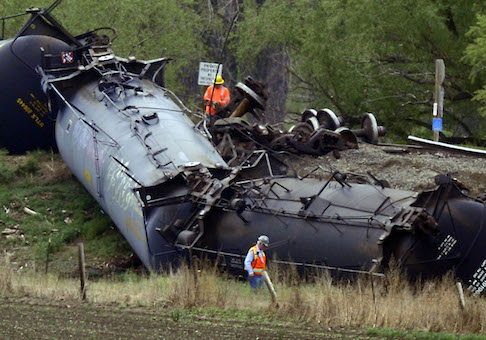As both houses of Congress ready votes on the Keystone XL pipeline, federal energy regulators on Thursday revealed a large year-over-year increase in the amount of oil transported by rail, particularly from areas that Keystone’s southern leg would serve.
The increase in rail traffic could boost the case for Keystone, whose supporters say it offers a safer alternative to rail transportation in the wake of a number of derailments of trains carrying crude oil, some of which have resulted in loss of life.
According to the Energy Information Administration, a lack of pipeline capacity from booming shale oil deposits in North Dakota contributed to a 13.4 percent increase in rail shipments of crude oil since this time last year.
"Rising U.S. crude oil production, particularly in North Dakota's Bakken Shale formation, where pipeline takeaway capacity is limited in moving the state's growing oil volumes to market, is one of the main reasons for this increase in rail shipments of petroleum and petroleum products," EIA said in a Thursday report.
Keystone’s supporters say the project would relieve pipeline congestion and provide an alternative to rail transit, which they say is significantly more hazardous.
"The no action alternative of rail is a misguided plan," according to Brigham McCown, the former head of the Pipeline and Hazardous Materials Safety Administration. "Pipelines have proven themselves to be safer, more environmentally friendly, and more cost effective than the alternative."
That is particularly important for the Bakken, the epicenter of skyrocketing U.S. oil production, where a Keystone "on-ramp" could alleviate transit congestion, according to Katie Brown, a spokeswoman for the industry site Oil Sands Fact Check.
"Not only will it bring jobs and economic growth, it will also provide an on-ramp for Bakken crude, which will alleviate concerns about pipeline capacity in those states," Brown said in an emailed statement.
EIA’s data comes as both the House and Senate prepare to vote on legislation that would expedite the approval of the southern leg of the Keystone pipeline.
Each chamber’s measure is sponsored by a candidate for U.S. Senate in Louisiana, which houses refineries to which Keystone would carry Canadian "oil sands" crude.
Democrat Mary Landrieu is leading the effort in the Senate, while her Republican opponent in that state’s runoff election, Rep. Bill Cassidy, pushes House legislation.
The latter is expected to receive a vote on Friday.
Cassidy and other House Republicans have stressed that Keystone represents a safer transpiration alternative to rail.
According to an analysis by the State Department, rejecting the project would result in 2,947 injuries and 434 deaths over the next 10 years as oil companies operating along the pipeline are forced to transport their product by less-safe means, including rail.
The Obama administration has repeatedly delayed a decision on the Keystone pipeline, which requires approval by the State Department because it would cross the U.S.-Canada border.
Bakken production has soared in recent years, but pipeline capacity remains limited. Many North Dakota producers have been forced to bring crude to market via rail as a result, according to a June EIA report.
Recent oil train derailments have highlighted the relative dangers of that mode of transportation. One such disaster in Quebec this year killed 47 people and resulted in an environmental catastrophe.
